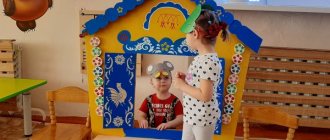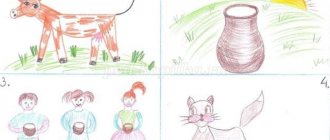Summary of joint activities using mnemonic tables “From the life of wild animals”
Vera Novotnaya
Summary of joint activities using mnemonic tables “From the life of wild animals”
Tasks:
1. To consolidate children’s knowledge about the wolf (appearance, habits, lifestyle , features of hunting in winter and summer, benefits and harm from the wolf.
2. Continue to develop logical and imaginative thinking, attention and imagination, auditory and visual memory; ability to establish associative connections; learn to cut a literary text.
3. Learn to compose descriptive stories, develop coherent and demonstrative speech; enrich children’s vocabulary using the words “leader”
,
“flock”
,
“den”
.
Material:
mnemonic tables : “ Wild animals ”
,
“Wolf”
, pictures depicting
wild animals : fox, wild boar, hedgehog, bear, hare, squirrel, elk, wolf; cards (photos)
with graphic images of these
animals , pictures depicting tracks (man, dog, wild boar, horse, hare, wolf, game letter with tasks, postcards - 10 pieces, a poem about the forest, simple pencils, sheets of paper for cutting the poem .
Familiarization with fiction using the mnemonic table “On domestic and wild animals”
Nadezhda Baynazarova
Familiarization with fiction using the mnemonic table “On domestic and wild animals”
Thematic week: “Animals”
Theme of joint activity of the teacher and children:
“About
domestic and fairy-tale animals ” Age: middle preschool Direction of development: speech
(reading
fiction ) Integration of educational areas:
“
cognitive development ” ,
“speech development”
,
“physical development”
Tasks: Speech development: Develop coherent speech, memory, thinking.
Cognitive development : Develop the ability to simultaneously identify three properties of geometric shapes (shape, size and color)
.
Physical development. Stimulate physical activity through physical education. Methods and techniques: visual: Kuzya doll (brownie, chest, mnemonic table; verbal : conversation, questions. practical: physical education minute, didactic game. Materials and equipment: Demonstrative material: Kuzya doll (brownie, chest, mnemonic table “Winter”
, to the fairy tale
“Winter Hut”
; pictures depicting
wild and domestic animals (squirrel, hare, wolf, bear, bull, ram, cat, pig, rooster)
; a set of geometric shapes of different colors; three hoops Forms of organization of joint activities: motor: play exercises perception
of fiction : reading, discussion
Logic of joint activities of the teacher and children
1. Working with the mnemonic table “Winter”
.
Kuzya the brownie appears and invites everyone to go to the book corner. Kuzya: Today I was walking through the forest and saw completely incomprehensible things: the hare turned white, the squirrel also changed its fur coat from red to silver, and the bear generally fell asleep. What happened to him? The children explain to Kuza why this happened to the animals.
-How did the animals know that winter had come? Working with the mnemonic table “Winter”
. Children look at the pictures in the table and describe the signs of winter.
Kuzya: Thank you guys for explaining everything to me. I’ll give you a new fairy tale for this. The animals there are domestic , unusual, fabulous, so they were able to survive in the forest even in winter. (Takes out a mnemonic table )
Let's first remember what
domestic and wild animals we know . (Children answer first according to the fairy tale mnemonic table , and then according to sets of pictures). But before reading a new fairy tale, we will warm up .
Physical education: Once upon a time, along a forest path, the animals were going to a watering hole . The elk calf was stomping behind the mother moose. A little fox was sneaking behind the mother fox, A hedgehog was rolling behind the mother the hedgehog, A bear cub was following the mother bear, The squirrels were jumping after the mother squirrel, The squirrels were jumping after the mother squirrel, The slanting hares were following the mother hare, The she-wolf was leading the wolf cubs - All mothers and children want to get drunk
3. Introduction to the fairy tale “Wintermovie”
Reading a fairy tale; joint telling of a fairy tale using a mnemonic table .
Questions: What animals live in this fairy tale ? How many were there? Think about when these animals were small , what they were called (Bull-calf, etc.)
4. Game “Hide a fairy tale inside geometric shapes”
.
There are three hoops on the floor, with a set of geometric hoops inside them. The teacher suggests dividing into 3 teams to stand around these hoops. Among the geometric figures we will find the heroes of the fairy tale. For example: The bull is large and brown, which means the bull is a large brown rectangle, the ram is a gray square, the smaller pig is a pink oval, the cat is a small white oval, the rooster is a blue triangle.
Kuzya. Guys, what would happen if the animals built a house separately , like in the fairy tale “The Three Little Pigs”? (Children's guess)
That's right, that means they say that if you live in friendship, no one will win. Well done guys, you are real friends.
6. Reflection. - Guys, what did you like about the fairy tale?
Business game for educators “Introducing preschoolers to fiction” Business game for educators “Introducing preschoolers to fiction” Senior teacher of MDOU kindergarten No. 4 “Solnyshko”, Furmanov.
Consultation “Introducing preschoolers of the seventh year of life to fiction” The intellect of children of this age is sufficiently developed to perceive many problems of life and art that are interesting and attractive to them.
Familiarization with fiction. Reading the fairy tale by K. Chukovsky “Chicken” Goal: to introduce children to the literary work of K. Chukovsky “Chicken” Objectives: Developing free communication with adults and children.
Familiarization with the fiction of children with mental retardation. Fairy tale by V. Suteev “The Ship” Objectives: to introduce the content of a modern fairy tale; learn to listen to a short fairy tale; continue to learn to distinguish between literary ones.
Familiarization with the fiction of children with mental retardation. Fairy tale by V. Suteev “Under the Mushroom” Objectives: to introduce the content of a modern fairy tale; learn to listen to a short fairy tale; continue to learn to distinguish between literary ones.
Familiarization with fiction and speech development Fiction opens and explains to the child the life of society and nature, the world of human feelings and relationships. She develops.
"Unknown Soldier". Introducing children to fiction (using ICT) I would like to share with you my presentation “The Unknown Soldier”. On the eve of the celebration of the 70th anniversary of the Great Victory, many events were organized.
Source
"Wild animals". Summary of a lesson on writing a descriptive story based on a mnemonic table
Marina Banshchikova
"Wild animals". Summary of a lesson on writing a descriptive story based on a mnemonic table
«Compiling a descriptive story based on a mnemonic table»
Planned results: knows and names forest animals , has an idea about their life, has, makes up a related story using a mnemonic table .
Integration of educational areas: cognition, communication, socialization, artistic creativity.
Organized structure of a game lesson
Stage 1: Motivational incentive
Guys, look what a beautiful ball flew to us. Look at what's hanging on the string. This is a letter from a baby elephant. Guys, the letter is not simple, it is written with icons and shows the letter to the children: After all, the baby elephant does not know how to write or read. But you and I know how to decipher letters. Let's try to do this together. Sit more comfortably near the colored circles.
(solve the text of the letter)
Stage 2: Organizational and search
“Hello, I'm a baby elephant, I live in Africa. We have many different animals . But, unfortunately, I have never seen taiga animals and I don’t know what they look like. Therefore I ask for your help. Could you tell me about these animals and send me your stories ? I will be very glad if you can fulfill my request. Goodbye".
Mnemonic tables for describing forest animals
Irina Suslova
Mnemotables for describing forest animals
Dear colleagues, nowadays preschoolers are increasingly experiencing problems such as: a poor vocabulary, inability to coordinate words in a sentence, impaired sound pronunciation and attention. When the teacher asks to talk about someone or something, the child very confusingly, tongue-tiedly describes the object , toy, animal . Descriptions fail because children find it difficult to build a chain of stories. One of the methods in the development of children's speech is the method of mnemonics . I offer you several tables to help you write a descriptive story about a forest animal . These tables can be used in middle preschool age. I used them in the GCD “ Forest Animals ”. Like any work, mnemonics are built from simple to complex. mnemonic tables in GCD .
Attached files:
“Mnemotables for learning poems with middle-aged children.”
I have been using mnemonics in my work for several years now. Now I have children 4-5 years old. All the poems we learn, we try. Mnemonic tables for memorizing poems Master class: “Mnemonic tables for memorizing poems” Today I would like to present to your attention the mnemonic tables that we made. Mnemonic tables for memorizing poetry with children aged 2–4 years Karepova L.Yu. teacher of the preschool institution “Raadiku”, Tallinn, 2021 Predominant among children of preschool and primary school age. Pedagogical project for children 5–6 years old “Children about forest animals” municipal budgetary preschool educational institution “Kindergarten No. 78 “Istok” in the city of Smolensk Pedagogical project for children.
"Striped towels for forest animals." Summary of direct educational activities Educational field: artistic and aesthetic development. Integration of educational areas: speech development, social and communicative.
Drawing up a mnemonic table for effective memorization of a poem Hello, dear colleagues! On the eve of the “Cosmonautics Day” holiday, I bring to your attention a mnemonic table for memorizing a poem.
Dance of forest animals for boys of middle groups “Come on, Christmas tree, brighten up” Dance of forest animals for boys of middle groups “Come on, Christmas tree, brighten up” Introduction boys form a circle 1. Along the paths in the snow, along.
Technological map “Treats for forest inhabitants” for the first junior group Technological map of organized educational activities first junior group Educational area: Communication, creativity Section:.
Lesson “Visiting forest animals” for the younger group Integration of educational areas: speech development, social and communicative development, cognitive development, physical development.
Source






